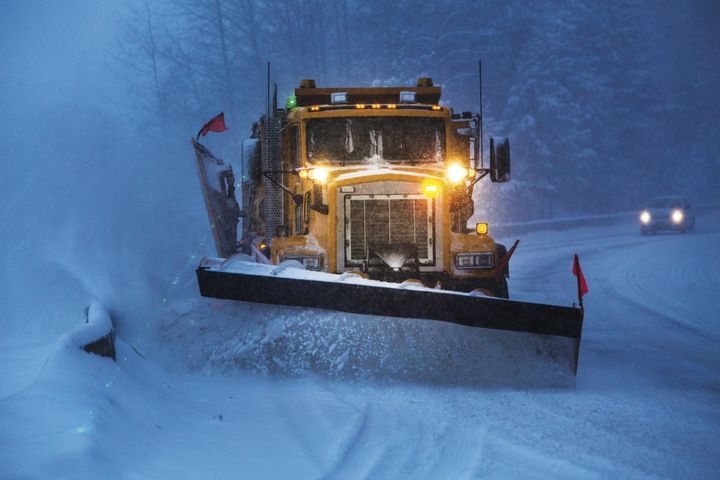Photo via Getty Images
The number-one thing public agencies should be concerned with in a snow event is keeping constituents safe, according to Amin Amini, managing partner of solutions engineering for Verizon Connect. And part of that is plowing roads quickly and efficiently.
Telematics technology can help public agencies accomplish this — while also providing data points that can offer transparency, control and reduce salt use, and protect drivers.
1. Find your vehicles and know if they’re ready to go
The first thing fleet managers need to know before deploying vehicles is where they are and what condition they’re in, Amini said. UTVs, pickup trucks, and heavy vehicles may be in different areas of a city or county and knowing exactly where they are will help ensure the quickest response. And telematics can identify what condition vehicles are in ahead of time to help fleet departments ensure their vehicles are in good condition before they need to be used.
2. Plan routes and track vehicles
Telematics can also help with route planning or be integrated with an existing route planner.
For large municipalities with multiple drivers taking multiple shifts, accurate routing and tracking data allow snow operations staff to send new drivers out to areas that haven’t been treated, Amini said.
Sometimes, things don’t go according to plan. For example, a new driver may be unfamiliar with a route and miss a turn, or an obstruction on the road prevents the driver from passing. Magellan’s Return to Route feature gets drivers back on their routes as efficiently as possible, according to Ted Lee, head of business and product innovation for Magellan.

Municipalities can use telematics data to exonerate their employees when a claim comes in about property damage, which is usually higher during snow season, according to Verizon’s Amin Amini. Photo courtesy of Verizon
3. Know whether a street has been plowed, and when
Fleet managers can know whether plowing or spreading has been performed. Telematics devices can detect whether a plow is up or down or if a spreader is on or off.
“This is important for municipalities to track to make sure service was performed well,” said Sherry Wu, product marketing manager for Samsara.
Wu added that Samsara’s system provides live, to-the-second GPS coordinates, providing better information than ones that send data every 30 seconds or longer.
4. Know how much salt or sand you’re using
“A more advanced feature is the ability to integrate with spreader controllers to determine what is being spread and how much is spread,” said Chris Jackson, vice president of government operations for BSM, a Geotab company.
“In Canada, where salt is considered a toxic substance, agencies that use more than a certain amount are required to create a salt management plan,” Jackson explained. “Telematics can track salt use much more accurately than counting the buckets of salt added to a truck.”
In the U.S., government agencies are more driven by cost, and salt costs can be high and fluctuate. Tracking salt dispersal can allow agencies to reduce salt use.
“It will show the real-time rates and if the actual rates are not where they should be, they can say, ‘Well, those vehicles aren’t calibrated,’ and they can address those issues,” Jackson explained.
5. Inform the public
Another important benefit of telematics is transparency and to show citizens when their streets have been or will be plowed. Many public agencies have websites where citizens can view this information, and the plow up-down or spreader on-off features help ensure it’s accurate.
“Prior to this rich telematics data, it was all assumptions, knowing that they’d sent out a driver to plow X roads and hoping it was complete,” Amini explained.
And while it’s most helpful to know whether and when a street has been plowed, Jackson said fleets that aren’t ready for that can simply show vehicle location data.
“The purpose of that, for some agencies, is to show, ‘Hey, we’re out there, we’re working,’ and to provide that transparency,” he explained.

Telematics can show where a vehicle has been and the diagnostic information for that vehicle. Pictured is the dashboard for Samsara. Photo courtesy of Samsara
6. Protect your operators
During snow events, the number of property damage claims goes up, Amini said.
“So what municipalities are using this data for is to exonerate their employees when a claim comes in about a snowplow driver or for property damage. They can go into the platform and say, ‘No, Mr./Mrs. Constituent, in fact, our operator was not at your house, or your street, or your mailbox during this window of time,’” he said. “Drivers welcome that kind of exoneration, because for far too long, it’s been very perception-based and not data-based.”
Safety Is the No. 1 Goal
“When you’re dealing with winter storms, response times matter,” Wu, with Samsara, said.
And while using salt efficiently and knowing vehicle condition data can help fleet managers make smart decisions, telematics’ most important benefit for winter operations may be quick and efficient plowing and spreading to ensure safety on the roads.
by Thi Dao
Source: https://www.worktruckonline.com
CUT COTS OF THE FLEET WITH OUR AUDIT PROGRAM
The audit is a key tool to know the overall status and provide the analysis, the assessment, the advice, the suggestions and the actions to take in order to cut costs and increase the efficiency and efficacy of the fleet. We propose the following fleet management audit.





